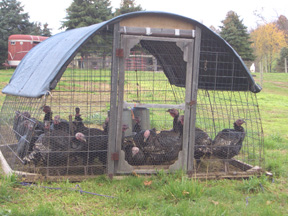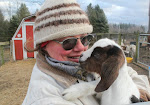
I raise a flock of Heritage turkeys on pasture each year because I like the taste of grass-fed poultry and I want to make sure the bird that graces my holiday table hasn't been stuffed in some fetid commercial poultry house breathing fecal fumes and been subjected to the mutilation of having its beak and toes chopped off to prevent the cannibalism that is commonplace in overpopulated poultry operations. The first year we moved to the farm in Pennsylvania, we bought poults from a local Mennonite family with a large turkey operation. They only had half a top beak and the scarred toes left alien prints in the dirt as their toes looked more like geko feet than that of a turkey.
So what's the big difference between a Heritage and a Commercial turkey is the most common question I'm asked and I always answer breasts & sex. Modern birds are the Dolly Partons of the turkey world. They've been selectively bred to grow gargantuan pectorals to please consumers. Unfortunately, at the same time, they've bred the ability for these top-heavy gobblers to reproduce naturally. We allowed four of our Mennonite-mutilated birds to reach adulthood--three hens and a tom. When spring came, the hens lined up ready to be services but the poor ol' tom could only give them some "wing". With his enormous chest, his tiny pecker (and I'm not talking about the half a pecker on his face) couldn't come close to hitting the mark. So we ate the turkey eggs along with the turkeys eventually.
Which leads me to the next most common question--how can you eat your turkeys? That's easy. Anyone who has ever raised turkeys will tell you that by the first of November they start chanting, "Three more weeks! Three more weeks!" I move two dozen birds in a portable house two to three times a day and by now the amount of crap they leave behind will gag even the strong of stomach. I can only imagine what thousands of these critters confined by the thousands in an enclosed building must be like.
I've also read enough USDA butchering regulations to know that the reason the health department suggests you incinerate a turkey to 180 degrees internal temperature is because of all the unsanitary conditions when the birds are processed. When anyone eats one of my birds, I've personally cleaned it and know that the intestinal tract hasn't been broken open by automated cleaning equipment thus contaminating the carcass with fecal matter--the source for pathogens that make people sick.
But there is one thing about my Heritage turkeys that I do love (beside the taste). There's something ethereal about stepping outside on a crisp autumn morning and hearing turkeys. They chirp and tribble some while young, but the familar gobbling doesn't begin until mid-October when the first frost appears against the backdrop of flame-colored leaves signalling fall.






Wow, a post about breasts and sex that even the MPAA prudes would approve. I'll have to remember this when I'm picking out my frozen Butterball this month. (We need to live a lot closer!)
ReplyDelete